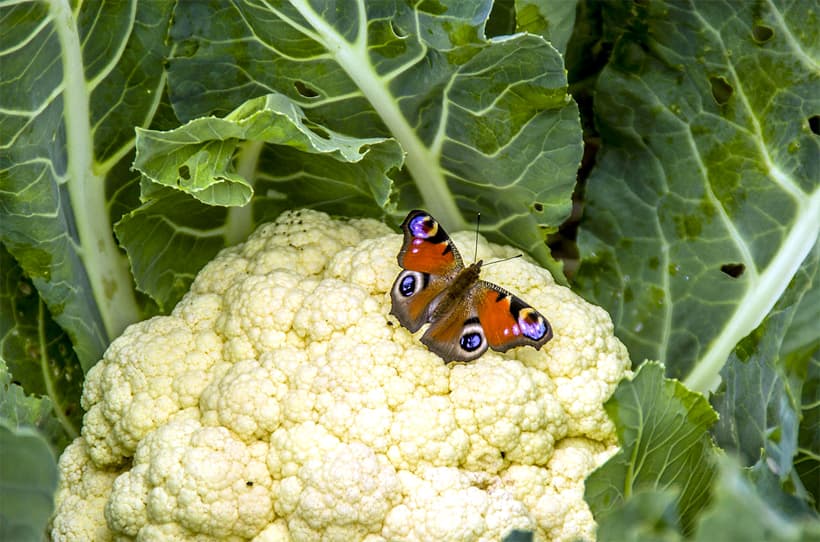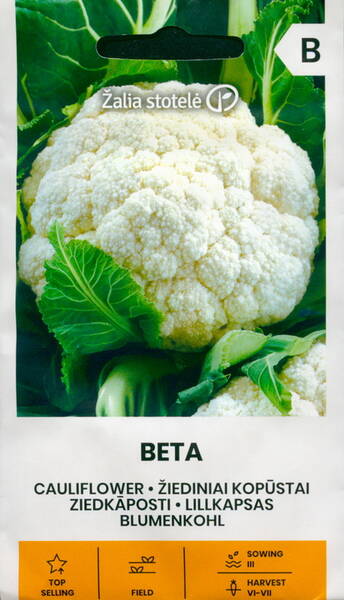Ex Tax: 0.85€
A very early variety intended for forcing and the earliest field growing. The heads are white, slightly bumpy, firm and highly resistant to turning violet and yellowing. The growing time from sowing to harvest is 58-63 days. The recommended plant spacing is 40 x 40 cm.
1,0 g = 500-550 seeds.
Cultivation.
Cauliflower requires good quality soil, rich with nutrients and with an ability to retain water. As well as good autumn fertilising with manure, it is necessary to ensure there is sufficient calcium and for the development of the heads the levels of trace elements (manganese, magnesium, boron and molybdenum) are important. Sowing of seedlings for the earliest cultivation is from January directly into trays and later on into greenhouses. Seedlings for spring growing need to be hardened off in order to be able to survive extreme cold (-6°C). Direct sowing is possible with varieties Delta and Octavian. The recommended plant spacing for direct sowing is 60 cm between the rows, reduced to 40-50 cm with precision drilling and 5 seeds per metre.
Seed consumption: 130-150 g/ha for well-calibrated sowing into seed trays. 200-250 g/ha for direct sowing.
Harvest: after reaching the required size for the heads, which for the earliest varieties is approximately 60 days after planting. Late varieties with well-covered heads can be harvested after frost down to -5°C.

* Cauliflower is a rather cold-resistant plant, the optimum temperature for its cultivation is +15+18°C.
Light. Cauliflower is a very photophilous crop, especially during the period of growing seedlings and leaf formation. It should only be planted in well-lit areas.
The soil. Cauliflower has a weak, fibrous root system that develops well in shallow soil layers. Therefore, cauliflower is demanding on fertility and soil moisture. Soil and air humidity should be 70-80%. At temperatures above +22°C, care must be taken to keep the soil constantly moist. Even a short-term overdrying of the soil of seedlings or adult plants leads to a deterioration in quality and a decrease in the yield of heads. Watering should be increased at the beginning of the formation of heads. It is desirable to mulch the soil under the plants. However, you should not fill it, because. Excess moisture causes plants to become sick.
Soil preparation. Cauliflower does well on loose loams or sandy loams with a high humus content. But in any case, you can not plant plants in freshly dug up soil, you should wait at least a week. Loose earth should be somewhat compacted. According to some reports, cauliflower (like cabbage) prefers hardened, prepared soil several months before planting.
The acidity of the soil is neutral or slightly acidic. Lime is applied in the autumn of the year preceding planting. If field horsetail, oxalis, sorrel grow on the site, this is an indicator of acidic soil. Doses of lime, depending on the acidity and severity of the soil, range from 0.3 to 0.5 kg / sq. meter. The most effective way to reduce acidity is to first sprinkle the soil evenly with lime or ash, and then sprinkle with manure (mullein), and then dig it up. Cauliflower responds well to the introduction of high doses of humus or compost. In this case, it should be borne in mind that the soil and the fertilizer used affect its taste. Cauliflower responds well to feeding with boron and molybdenum in the seedling phase.
Fertilizer for cauliflower is applied as well as for white cabbage. However, the best, warmer places are reserved for cauliflower. In the spring for 1 square. meter contribute: 6-8 kg of manure or compost, 20-25 g of double superphosphate, 30-35 g of potassium chloride or sulfate, 0.5 teaspoon of boric acid, ammonium nitrate 25-30 g or urea 15 g / sq. meter. To save fertilizer, some of them are brought into the planting holes, thoroughly mixing with the soil. Instead of part of the potash fertilizer, it is useful to use wood ash, especially in planting holes.
Growing seedlings. To get an early harvest, use the seedling method of growing. Seedlings are prepared in the same way as for early white cabbage. A potted method of growing seedlings is preferable to a potless one, because. potless seedlings do not tolerate transplanting well. Seedlings are prepared 7-8 weeks before planting in a permanent place. The term for sowing seeds for open ground and film shelters: the first time from March 15 to 30, then at intervals of two weeks until the end of May. Land for seedlings should be taken from the beds where cabbage and its relatives were not grown. The seeds are preliminarily disinfected, for example, they are heated for 20-30 minutes in water at a temperature of + 50 °C. Then dipped for 3-5 minutes in cold boiled water to cool. Seeds are sown in boxes to a depth of 1 cm through 2 cm with row spacing of 3-5 cm. Watered from a watering can, covered with glass. In the phase of the appearance of the first true leaf, the seedlings dive into pots or milk bags. An hour before picking, the seedlings are watered abundantly. You can immediately sow 2-3 seeds in pots or milk bags, and then pluck weak seedlings. With the appearance of the second true leaf or a week after picking, the seedlings are fed with a solution of 20 g of ammonium nitrate, 15 g of double superphosphate, 10 g of potassium chloride, or infusion of mullein diluted with water 5-8 times. The second time they are fed after 1-1.5 weeks. A few days before planting in a permanent place, seedlings are fed with microelements and hardened. For top dressing with microelements, take 0.12 g / liter of water of boric acid and molybdic acid ammonium.
Seedlings can be grown in cold greenhouses and potted and potless. Seedlings cannot be overgrown, because. you can't get quality heads out of it.
Transplanting. Cabbage seedlings are planted in a permanent place 6-7 weeks after germination. Standard seedlings should have 4-6 leaves, stocky. Seedlings of cauliflower are planted immediately after planting seedlings of early white cabbage. Seedlings are planted in the ground at several times, starting from April 25 - May 10 (under the net), then with an interval of two weeks until June 10. Seedlings are planted in the afternoon or in cloudy weather with watering. Seedlings are planted on a bed in 2 rows, the distance in a row is 30-40 cm, between rows is 50-55 cm. Planting depth is on the first true leaf. Fertilizer (a teaspoon of nitrophoska), 60-100 g of ash is added to the planting hole and mixed with the ground. When planting seedlings after abundant watering, the soil around the roots should be somewhat compacted. After watering, mulch with dry soil. If it is hot, then the transplanted plants should be covered with newspaper caps. The same is necessary for frost if the seedlings are not hardened.
When planting early, a net should be used to cover the seedlings. Under the net, the seedlings overheat less than under the polyethylene film and at the same time are protected from frost.
Reckless method. Just like cabbage, cauliflower can be grown in a seedless way. Seeds are sown taking into account the harvest in 90-100 days (for early varieties). Sow 3-5 seeds per hole, extra seedlings are pulled or planted. Plants grow stronger and healthier.
Care and Feeding. Since cauliflower has an underdeveloped root system located close to the soil surface, it is necessary to ensure that the soil is constantly moist. In dry hot weather, planted seedlings are watered daily. It is advisable to mulch cabbage with humus during the growing season (layer up to 6-7 cm). The soil is regularly loosened and weeded, the plants are bored.
Cauliflower consumes most of the nutrients during the formation of heads. By this time, top dressing should be timed, to which she, having a shallow root system, is very responsive. During the growing season, it is fed 3-4 times. 1-1.5 weeks after planting the seedlings, the first top dressing is done: half a tablespoon of urea and potassium chloride and 1 liter of mullein or 1 liter of mullein and 1 tablespoon of complete fertilizer are diluted in 10 liters of water. For one plant spend 0.5-0.7 liters of solution. The second top dressing is done 1-2 weeks after the first. The third top dressing is carried out when the rudiment of a walnut-sized head appears: dilute for 10 liters of water: half a tablespoon of double superphosphate, 1 tablespoon of full fertilizer. Top dressing is also carried out after long rains, because. nutrients are washed out of the upper layers of the soil (especially on light soil).
After top dressing, the soil is loosened, the plants are piled up and mulched. Heads must be protected from direct sunlight, rain and irrigation water. Therefore, when the head reaches a size of 5-7 cm, two or three near sheets are tied or broken over it.
Harvesting. The head grows in 2-3 weeks. It is impossible to be late with cleaning - this leads to scattering of heads. Heads are cut selectively. If the head of an early cabbage is carefully cut off, leaving the lower leaves, then shoots appear from the axils of the leaves, of which one of the strongest leaves is left, which gives a second harvest by autumn.
Growing. Plants of late sowing time, which by the end of September - beginning of October have a good leaf rosette and a head of about 5 cm and are not frozen, can be grown. They are transferred with foliage to a cellar, storage or greenhouse and added dropwise with moist soil (planted close). The temperature is desirable +2+4°C. The head slowly increases due to the outflow of juices from the leaves.
Pests and diseases. To combat the spring cabbage fly, the soil is covered with roofing paper immediately after planting the seedlings. You can cover young plants with a net. The mesh can also be used to protect against other pests. To combat cabbage aphids and whiteflies, as well as to scare away butterflies, several tomato or eggplant plants are planted, sprayed with infusions of garlic, etc.
Infusion of garlic with the addition of soap: grate 300 g of garlic on a fine grater into 10 liters of water, insist, strain, add 50-100 g of grated soap. It is necessary to carry out preventive measures not only on cabbage, but also on neighboring plants, so that pests (whiteflies) from neighboring crops do not fly to cabbage. For pest control in a garden plot, the most effective is the manual collection of caterpillars and slugs.
Check out this way to scare away butterflies: put empty chicken egg shells on sticks and place them among the cabbage.
Return of cabbage to the old place - in 3-4 years.
Unacceptable predecessors are turnips, swedes, radishes, radishes, rapeseed, yellow mustard, and other types of the Cruciferous family.












